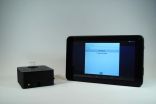(Press-News.org) The dull black plastic of the device on Joshua Pearce's desk belies its usefulness. Pearce picks up the box, which has a switch on the side and a small opening on top. A handful of vials sit in a bag nearby, and each would fit snugly in the opening. The set-up seems generic, even bland, except that it could radically change how we deal with water quality issues.
Pearce, who has a joint appointment as an associate professor of materials science and engineering as well as electrical and computer engineering, runs an open sustainability technology lab at Michigan Technological University. Along with his students, Pearce made the handheld device with a 3-D printer and open source hardware in collaboration with the Nitrate Elimination Company, Inc. (NECi). The small machine replaces comparable devices that cost more and rely on old methods based on cadmium or zinc. The idea is to create better tools for testing nitrate content in water and soils. This week, PLOS ONE published the team's research on the device.
"The beauty of this device is that it's extremely adaptable, more sensitive, safer and smaller," Pearce says. "We have both the 'business story' and the 'feed the people story' here."
Nitrate and Water Quality
High nitrate levels in water cause the dead zones in the world's largest deltas. Using too much nitrogen fertilizer wastes resources and leads to nitrate in runoff and water wells and an excess of nitrate in drinking water is a health hazard to infants and harmful to many animals. Current portable nitrate testers range in price and accuracy, from ballpark data at low price points to several hundred dollars for a handheld photometer. This new design is palm-sized, interfaces with a free Android app, costs less than $65 to manufacture and uses green chemistry for a safer and more accurate testing procedure.
"This is a Popeye-approved reagent methodology," Pearce jokes, adding that the enzyme used in the test kit is found in spinach and other leafy greens. "We're replacing a toxic heavy metal with something that you eat every day in your salad."
Kale and collards aside, Pearce is serious about how the enzyme, called nitrate reductase, makes for a better device since NECi considers the chemical processing from sourcing to disposal. The PLOS ONE paper is a validation study, and, Pearce says, the device not only works, it "performs as well as commercial proprietary systems for less than 15 percent of the cost for materials and is 100 percent open source."
Having freely available hardware and software is only part of what makes this new nitrate test kit an improvement in the industry.
Making a Better Test Kit
Ellen Campbell, the CEO of NECi, hopes to revolutionize standard nitrate testing--as well as phosphate testing and other procedures--so that everyone has access to more affordable and more sensitive equipment. NECi's nitrate test reagents are close to being standardized by the Environmental Protection Agency for use under the Clean Water Act. The US Geological Survey embraced the reagents in their labs.
"But it's been a long and painful process to reach this point, because the way scientists think of methods development, and the way the regulatory community thinks of it, is so different," Campbell says. Another challenge, she adds, is establishing a methodology that non-scientists can use.
"We thought, okay, regulators are starting to crack down on runoff from farms, people want to know that their well water is safe to drink, and citizen monitors need better tools," Campbell explains. "We set out to simplify our enzyme-based methods so that anybody can use them."
Whether the end user is a farmer, citizen-science group, water treatment plant or government agency, Pearce and Campbell saw a need to streamline access to the equipment and data. The device is paired with a free tablet app provided by NECi and was made using 3-D printing and open source electronics and software. That not only makes the system less expensive and more accessible, but also customizable.
Pearce notes in the paper that the device can be adapted for different chemical measurements as it was derived from their earlier open-source 3-D printed laboratory work on colorimeters and water testing platforms. Minor modifications--and different reagents or complementary tools used to test samples--can create test kits for phosphate, microbial activity, turbidity, biofuel composition and UV applications.
One of the biggest benefits, Pearce says, is making quality equipment available to schools. Campbell and NECi have been working with a school in Virginia to test out the devices in classrooms.
"We need better ways to inspire up-and-coming scientists; what better way than to have them use real equipment and gather real data in their communities?" Pearce says. "We are working to make this nitrate test kit available to everybody."
INFORMATION:
COLLEGE STATION - Woody plant encroachment is one of the biggest challenges facing rangelands worldwide, but it consistently has been under-measured and poorly understood, said a Texas A&M AgriLife Research scientist in College Station.
Dr. Matthew Berg, an AgriLife Research postdoctoral research associate in the Texas A&M department of ecosystem and science management, is trying to change both the understanding and measurement with his latest study, which was captured in the July issue of the Rangeland Ecology and Management publication, http://bit.ly/1JK8JhU.
Berg ...
Accurately forecasting future electricity needs is tricky, with sudden weather changes and other variables impacting projections minute by minute. Errors can have grave repercussions, from blackouts to high market costs. Now, a new forecasting tool that delivers up to a 50-percent increase in accuracy and the potential to save millions in wasted energy costs has been developed by researchers at the Department of Energy's Pacific Northwest National Laboratory.
Performance of the tool, called the Power Model Integrator, was tested against five commonly used forecasting ...
Fundamental differences between how the brain forms during adolescence have been discovered in children with schizophrenia and their siblings, a new study shows.
The study opens up new avenues for researchers to explore when developing treatment for the illness, which can be hugely debilitating for children.
Researchers from the University of Melbourne and the National Institute of Mental Health in Washington DC used structural brain magnetic resonance imaging (MRI) to map the brains of 109 children with childhood-onset schizophrenia (COS), from ages 12 to 24.
They ...
The DZD-researchers at Helmholtz Zentrum München and German Diabetes Center Düsseldorf analyzed more than 1.800 blood samples of participants, who joined the German large-scale study KORA*. Using a comprehensive approach, the scientists investigated metabolic products (metabolites) as well as genetics of these participants. They found that the administration of Metformin** in patients suffering from Type 2 Diabetes led to a change in metabolite levels. According to the authors, this was associated with a significantly decreased level of LDL cholesterol***, which ...
First the scaffold is cracked, then defective parts are removed: Cells repair damaged DNA by a different mechanism than so far assumed, as chemists from Ludwig-Maximilians-Universitaet (LMU) in Munich have shown.
Defects in DNA can cause serious harm to an organism, including cell death or the development of cancer. Efficient repair mechanisms are therefore of vital importance. LMU chemist Professor Christian Ochsenfeld, Chair of Theoretical Chemistry at LMU, and Dr. Keyarash Sadeghian from his group have explained for the first time in detail how a human DNA repair ...
ARLINGTON HEIGHTS, Ill. (August 6, 2015) - There are times when emergency physicians can't be 100 percent sure a person is suffering from a severe allergic reaction, known as anaphylaxis, and may hesitate to use epinephrine. A new article says when in doubt - administer the epinephrine.
An article in the Annals of Allergy, Asthma and Immunology, the scientific publication of the American College of Allergy, Asthma and Immunology (ACAAI), highlights recommendations from a panel discussion among allergists and emergency physicians. The panel of experts examined barriers ...
Scientists at the University of Newcastle, UK, have used a combination of small molecules to turn cells isolated from human skin into Schwann cells - the specialised cells that support nerves and play a role in nerve repair. This new method generates large and pure populations of Schwann cells and hence is a promising step forward for the repair of peripheral nerve injuries. This research has just been published in the scientific journal Development at http://dev.biologists.org/
Currently, nerve repair strategies involve taking grafts from patients and using these to ...
TORONTO, August 5 2015 -- The term "self-regulation" has started appearing in children's report cards of late, but what it means is often unclear to parents. Thanks to three York University researchers, who have created a clear-cut definition for learning this important psychological concept, parents and teachers can now have a better understanding of what "self-regulation" means and how they can help their children develop that capacity.
"My hope is that every parent whose child has had a meltdown in a mall, and every teacher who has to work hard every day to prevent ...
PHILADELPHIA -- Moles are benign tumors found on the skin of almost every adult. Scientists have known for years that a mutation in the BRAF gene makes them start growing, but until now haven't understood why they stop. Now, researchers from the Perelman School of Medicine at the University of Pennsylvania have identified a major genetic factor that keeps moles in their usual non-cancerous, no-growth state. The study was published online first this summer in the journal Cancer Discovery.
"The BRAF mutation that stimulates the initial growth of moles also stimulates the ...
Glenview, Ill. (August 5, 2015)-- Researchers may be closer to finding the mechanism responsible for loss of lung elastic recoil and airflow limitation in nonsmokers with chronic asthma. The study published today in the journal CHEST Unraveling the Pathophysiology of the Asthma-COPD Overlap Syndrome reported that both nonsmokers and smokers with chronic asthma share features of COPD. This conundrum, often referred to as asthma-COPD overlap syndrome (ACOS), has been assumed to be due to large and especially small airway remodeling.
The study found that many patients with ...

